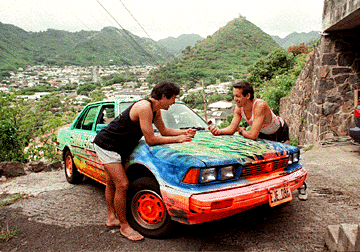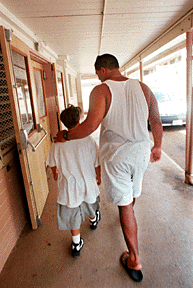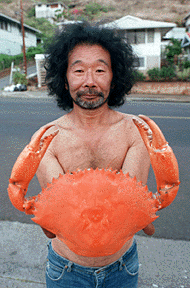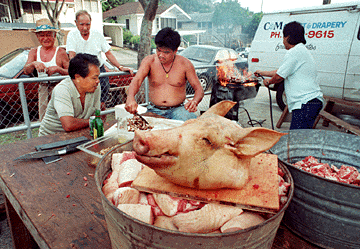
George Kon, left, and Brad Fleener talk story about the radical
paint job on Fleener's car. Palolo Valley is green behind them.

George Kon, left, and Brad Fleener talk story about the radical
paint job on Fleener's car. Palolo Valley is green behind them.
For newcomers, Palolo is less rustic, although a handful of farmers tend to acres of crops in the isolated reaches of the valley. The 33-acre quarry became a 200-home subdivision after it was closed in 1951, and the airplane field long ago was turned into Palolo Valley Housing.
 Palolo Elementary School student Emilo Ruiz, 10, and Akoni Sandoval share a moment during the "Kid's Kitchen" program.
Palolo Elementary School student Emilo Ruiz, 10, and Akoni Sandoval share a moment during the "Kid's Kitchen" program.
The 2,584-acre valley today is a mostly middle-class community of well-worn houses, with an orchid nursery and old folks home tucked in the back. The neighborhood mainstays of schools, churches and recreation center are scattered, but grocery stores and other small businesses are aligned mostly along 10th or Palolo avenues, the two main streets of the valley.
Tomorrow, Palolo Elementary School celebrates its 75th anniversary, with performances by students and a reunion of former teachers and principals.
For 13,500 people, Palolo is a comfortable place called home.
But Palolo has often been overshadowed by the more defined personalities of its neighbors - Manoa, Kaimuki and Kahala. It has often been dismissed by outsiders who don't realize the richness of the valley, say organizers of what is becoming a yearly celebration of "Palolo Pride." While many people "associate the valley primarily with gang involvement and domestic violence," Palolo advocates say there are many positive things in the community just waiting to be touted.
Barbara Ryder, co-owner of Frank's Palolo Market, finds it "kind of hard to associate Palolo with crime. My customers (many of whom come from the housing project nearby) are regular people concerned about the welfare of their children, about making a living. They take life as it comes."
Dennis Dobies, principal of Jarrett Intermediate School, admits having to fend off the old reputation of his school as being rough and rowdy, but maintains it's no longer justified.
 Larry Yanagihashi shows the Samoan crab
Larry Yanagihashi shows the Samoan crab
he plans on having mounted as a gift to his son.
There are no fights these days, he said, and, he points with pride to litter-free grounds and graffiti-free walls. Instead of gang symbols spray-painted on buildings, there are colorful murals, painted by students on weekends as service projects.
The second annual Palolo Pride Celebration will take place Saturday at Palolo Valley District Park. Last year, 7,000 people joined in the fun.
"I was amazed at how many well-known people live in Palolo," said Dwight Ovitt, who got married in the valley in 1973 and moved there in 1987. The musical groups Palolo and Ka'au Krater Boys are so proud of where they came from they picked names that tell it to the world.
Palolo is a place where roots go deep. It's where many World War II veterans, niseis like Robert Fujita, found new homes, raised children and now live in retirement.
"Most of (my neighbors) are Japanese because we all came back from the war in Europe and either just got married or were going to get married" when the hilly Carlos Long subdivision opened, said Fujita, who served as an interpreter in the Philippines in WWII. He later became a chemist, lobbyist and Democratic Party stalwart.
He remembers paying $11,500 for a three-bedroom home in 1950.
In those early years, every time it rained, the banks of Palolo Stream would overflow and Palolo Avenue would be impassable, Fujita recalled.
Back then, the Carlos Long Community Association held yearly bazaars, soapbox derbies for the kids and picnics at Ala Moana Park. "We were a really close-knit neighborhood. We had Christmas parades, Easter egg hunts, Cub Scouts, Girl Scouts, Boy Scouts, a softball league," Fujita reminisced.

People on 10th Avenue get together to prepare food for an
open house party. From left, Fredo Pascua, Manny Hermano
and George Delaguiar.
When Clifford Nishina moved into Palolo a half century ago, the valley behind Kaimuki was just beginning to develop into a full-blown residential community.
"This was a new subdivision," he said of his Mahana Street neighborhood just below Jarrett Intermediate.
Palolo was covered by kiawe brush and horses could be found grazing in fields, he said.
Nishina, now 84, remains active in the Palolo Lions Club that he helped to found in 1953. Just about that time, in 1952, the Palolo Community Council, also was formed, pulling together different community groups into one powerful voice.
 Carly Rose, 4, who lives at the Palolo Housing project, poses for a picture.
Carly Rose, 4, who lives at the Palolo Housing project, poses for a picture.
The council is credited with pressing for a number of improvements to the valley, including road and drainage improvements, as well as school and recreational facilities. The council is now working on a history of Palolo, said longtime president, Edward J. Pacheco. Pacheco, who also founded and organized the Palolo Little League in 1967, has vintage programs of the dedication of the Palolo Recreation Center gym and the Palolo fire station, both in November 1971.
Although there are many oldtimers like Nishina, Fujita and Pacheco in Palolo, Ovitt, a former teacher and former director of a refugee program in public housing, sees the valley changing.
Many older homes are falling into disrepair (a typical Palolo home is 42 years old), he noted, and many new homes are being built.
Ethnically, the faces of the valley also are changing, Ovitt said. While longtime residents tend to be middle-class and of Japanese or Chinese ancestry, the newer faces are of Laotian and Vietnamese immigrants, he said.
Dobies also has seen major changes since he first went to Jarrett, where his students included the Ka'au Krater Boys, in 1973. He left after five years but returned to Jarrett last year as principal.
The school has changed "drastically in size, make-up, focus, curriculum, attitude," he said. "Everything for the better."
Twenty years ago, there were more than 1,000 students at Jarrett. Today, there are just over 400 students in grades 6 to 8. Having fewer students allows the school to be "more child-centered, to have more activities, to be more hands-on," he said. With fewer students on the 10-acre campus, there are also fewer confrontations. "We have very few discipline problems," Dobies said, "whereas back in the '70s, I felt I was a referee."

Dennis Dobies, principal at Jarrett Intermediate School, has lunch with Aaron Trigilio, an 8th grader at the school.
Ovitt can't see living anywhere else but Palolo. "It's like living in the country, but it's close enough to the city," he said. "There are fighting cocks in (some) backyards. It's a wonderful valley for hiking."
Tenth Avenue "is kind of like the main drag but it's like the old days, like how Kaimuki was when I was growing up," said artist and gallery owner Noelani Block.
"I like this community," said Ryder, who lives in Kaneohe. "I don't know what it is I like. But when customers come in, they don't come here crabby" or with an attitude. They wait patiently in line or motion for someone to go ahead. "You don't feel like it's them against us."
What: Second Annual Palolo Pride Celebration
When: 10 a.m. to 6 p.m. Saturday
Where: Palolo Valley District Park, 2007 Palolo Ave.
Featuring: Emcee Ray Bumatai, 10 a.m. to 2 p.m.; Royal Hawaiian Band, 11:05 a.m. to noon; Dennis Pavao, 12:05 p.m. to 1 p.m.; Palolo, 3 to 4 p.m.; Ka'au Krater Boys, 4 to 5 p.m.; and many others, plus dancers, artists, crafts, games, sports, ethnic foods and local businesses
Sponsors: Palolo Pride Celebration Palnning Committee and the Mayor's Committee on Culture & Arts